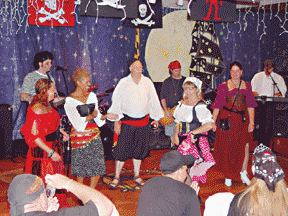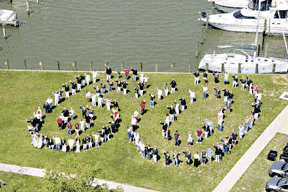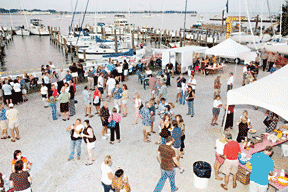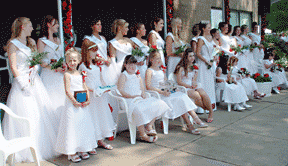|
|||||||||
The Secret Life of YachtiesClubbing up for camaraderie, not snobberyby Alice SnivelyThey come from distances short and long. Some arrive on Friday, more on Saturday morning. A special meeting precedes a ritual of spring: the shakedown cruise.
Fleet captains at yacht clubs all around Chesapeake Bay rally their members to limber up vessels dormant since autumn — not to mention their captains and crews. Flotillas of all sizes and types of boats ease into the Bay, those aboard praying there are no major malfunctions. But if problems arise, there is safety and assistance in the proximity of friends. That’s one of the perks of yacht club membership. Yachting in this country began as a male-dominated, racing-oriented sport for the wealthy. Enthusiasts formed associations to further the sport. The first in the United States, New York Yacht Club, was born in 1844 and incorporated in 1865. Yachting has since evolved to include the whole family and, in the age of fiberglass and mass production technologies, is much more affordable. Yet the word yacht still has the old associations of wealth and privilege. It needn’t. The Dutch jacht began as a verb meaning to hunt or chase. From there it came to describe a class of light, fast sailing vessels used in centuries past to apprehend pirates and other maritime miscreants. We use the word to describe a wide range of vessels designed for racing or pleasure whether powered by engine or sail. Ask six people for a more specific definition and you’re likely to get six differing answers, if you get my drift. As one of the oldest clubs on Chesapeake Bay celebrates its centennial, we look inside to see what keeps these confederations afloat and how they differ from marinas. What really goes on behind those locked gates and closed clubhouse doors? It’s time to unmask the secrets of the yachties. Secrets of the YachtiesActually, the secret is that there are no secrets; rather a lack of information that this story may help remedy. Yacht clubs are generally private, member-owned, not-for-profit corporations. Some have paid employees, while others are managed entirely by members, hereafter referred to as yachties. (I can get away with this; I am one of them). Marinas, on the other hand, are for-profit commercial entities established for the purpose of berthing boats, often providing marine repair services. But many of us are yachties because of the fellowship of the club environment. Yacht Clubs do observe unique traditions that provide the glue — we yachties would say the 5200 bonding agent — holding the community together. That doesn’t make us all wealthy, old, and snobby. We’re not the stereotype Commodore Carey Kirk of Eastport Yacht Club likes to debunk: “guys in blue blazers with brass buttons and fancy boats.” Our yachtie ancestors might well frown on some of the goings-on at today’s yacht clubs, but they’d be relieved to discover that not all their traditions have been abandoned. The six Chesapeake Country clubs we investigated retain officer hierarchy and election traditions begun more than a century ago. The bridge of officers traditionally includes a commodore, vice-commodore, rear-commodore, treasurer, secretary and at least one fleet captain. Most clubs also have a governing board comprised of the officers and additional members elected at large.
Most clubs hold these Change of Watch elections in the fall to give the new bridge time to organize events for the following year. Nearly all host Opening Day ceremonies in late spring to officially launch the new boating season. The Commodore’s Ball is another traditional event, given to honor the incoming commodore and officers. The Fleet Review — a parade of the club’s boats surveyed by the officers and other members — continues, and of course most clubs sponsor races in keeping with the original purpose. Each yacht club identifies itself and its members by its burgee, a pennant-style flag incorporating the club’s colors and insignia. Cheers at Solomons IslandEstablished in 1937, Solomons Island Yacht Club observes its share of old traditions, but it also hosts a Christmas Parade of Lights, a more recent community-oriented celebration. Another of the non-traditional events on its calendar is the Come As You Were party, a jolly gathering where members are asked to dress as they did during their high school years. Regarding the social aspects of membership Commodore Gary Strausser said, “I think some believe yacht club means stuffy older people.” He says this image just doesn’t fit the reality. “Every time I walk into our clubhouse it reminds me of Cheers. I’m comfortable. I know I’m welcome.” Its clubhouse facilities include a dining room and the Captain’s Lounge with one of the largest displays of club burgees on the Bay, such as the one from Royal Oak Yacht Club, Cork, Ireland, the oldest yacht club in the world, established in 1720. The club is located on the island at the mouth of the Patuxent River has 30 boat slips, but it’s surrounded by a cluster of marinas. Contrasting his club to these commercial enterprises, the commodore said, “We come together, to help each other; we own the place and this makes the big difference.” The sense of ownership also helps create and maintain the close social bond that is a hallmark of the experience shared by the club’s 200 members. Chesapeake’s Bizarre BazaarShady Side is the home of Chesapeake Yacht Club, but there’s nothing shady about this very active organization 30 minutes south of Annapolis. Social activities include organized cruises, picnics and dock parties, but yachting traditions continue in its official structure and events such as the Commodore’s Ball and Opening Ceremonies. One of its most popular neo-traditional events is the annual bazaar. Commodore Paul Kowalski says it’s a favorite fund-raiser inciting friendly competition among the club’s four docks. “It’s a very fun time, with activities for the whole family.” Dock carts are filled with things members want to sell, and local businesses contribute items. Disposition is accomplished by a mix of raffle and auction. “We have a very good auctioneer, and one year he actually got the bidding so frenzied that a case of toilet paper sold for $60.” Definitely not the work of “stuffy older people”. The facilities at Chesapeake are representative of those found at many other clubs, including a spacious clubhouse with dining room and lounge, children’s recreation room, heated swimming pool with poolside bar and grill, laundry and shower facilities. There are 142 boat slips and currently about 125 members. There is also the security of a six-foot fence with member-controlled gates. On the subject of club versus marina the commodore said, “People may not appreciate that the club offers both a boating and social experience.” The Same, Only DifferentFor all the commonalities, each club is different from any other; the amenities and activities noted in this story are by no means inclusive. Several clubs offer cable television, telephone hookups and Internet access at their slips, for example. Most have a mix of power and sail boats. Some require boat ownership as a condition of membership, while others do not. Several have different types of memberships. Some require minimums to be spent at club dining facilities. Member participation in club management and maintenance is required at some clubs, while with others this is voluntary. Fee structures also differ. Some clubs have a range of memberships; some have chit fees for dining; some have initiation fees while others don’t. Some clubs charge for slips by the length of the boat; others by the length of the slip. Fees are kept within the clubs and prospective members; they are not published, even on club websites. Generational First for Selby BayIn the context of traditional officers, Selby Bay Yacht Club’s 2008 Commodore Bruce Oranburg follows his dad into the top spot. “It’s a first for us and I am honored and proud,” he said, explaining that his father Burton held the post in 1998. This year the club is also celebrating the 60th anniversary of its founding. Located on Selby Bay off South River, the club has 71 slips and about 100 members, both power and sail. The emphasis is on “fellowship in a family-friendly atmosphere,” exemplified by the inclusion of toy boat races among the many social events and cruises the club hosts. Amenities include a multi-purpose clubhouse with showers, large party space, a library and TV room and a computer with Internet access. There is a swimming pool with life-guard protection. Slips are wired with electricity, cable, wi-fi Internet access, water and optional telephone hook-ups. The commodore tells of a club tradition that created itself, “by accident:” “A few members got together for coffee and bagels at the clubhouse one Saturday morning, and it grew into a regular tradition. Now during boating season, we have the coffee and bagels every Saturday and Sunday morning for whoever is around and wants to share.” As to the value of the club experience, Oranburg said, “The club is run by the members, so they are looking after everyone’s interests. Collectively they have a wealth of nautical knowledge that’s willingly shared.” Eastport Burns Its Socks
Come December, Eastport Yacht Club will host its 28th Parade of Lights in Annapolis. Crowds of people from all over the region come to view the nighttime show of creatively decorated boats from this and other clubs as well as unaffiliated boaters. “Over the past five years we’ve averaged about 42 boats,” Commodore Carey Kirk said. Eastport is also the first club on Chesapeake Bay to take up the ancient tradition of the end-of-winter sock burning. The 27th installment of this ritual was held in March. The story varies somewhat depending on the teller; basically, sailors returning from long months at sea would hasten to the wholesale burning of their socks, for reasons that need no explanation. Your imagination can fill in the blanks. In addition to a very active social program, the club is renowned for sailboat racing, and the race committee runs some of the largest and most competitive races on the Bay. The clubhouse with dining room and lounge facilities sits on Sycamore Point at the end of First Street in the Maritime Republic of Eastport, across Spa Creek from Annapolis. Since its founding in 1980, the club has grown to a membership exceeding 600 yachties — though it has only 42 boat slips. One explanation is the context of organized fellowship. As Commodore Kirk says, “it’s the boating experience with a point of reference beyond slips: camaraderie.” Diverse Yet UnifiedYachties come in all types. But on the docks it doesn’t matter how long the string of digits on your bank balance, or the LOA (length overall) of your vessel. A passion for boating is the great unifier. Even the mock disdain shared by sail- and power-boaters for each other gets deep-sixed when it comes to the love of the sport. When someone’s trying to dock in a contrary wind, all available hands offer aid. The guy who has a spare part will give it to a needy neighbor when the marine stores are closed. Blue collar and white collar are meaningless in the clubhouse when the sea stories flow like the beer. Annapolis Yacht Club Racy ReputationThe fast sailboat kind of racy, of course, is this club’s renown. With roots going back to the 1880s, the club was reorganized and incorporated in 1937 and held its first annual regatta that year. Since, the racing program has grown to include a very active junior fleet along with adult racing. “Our Wednesday night races are very popular,” Commodore Peter Gordon said. “We hold these from May to September and average about 125 boats.” There’s also frostbite racing for those who enjoy plowing through the waves in chilly winds. (So far as I’ve been able to discover, the only difference between a race and a regatta is which word you use.) Among the large contests hosted by the club is the Etchell’s North American Championship. Located on the Annapolis end of the Spa Creek drawbridge, the large clubhouse has multiple dining rooms and amenities on three decks. There are also three marinas. The clubhouse-side basin has 30 slips and a dinghy dock. Directly across the creek is the Sailing Center, which has slips and dry storage for the club’s one-design racing fleets. Also across the creek and on the other side of the bridge is the Junior Sailing Center with 50 slips and storage for the junior sailing fleets. In recent years the club has increased its social activities. “Our fastest growing area is our cruising program,” the commodore explained. What began 10 years ago with six couples now averages 150 couples and includes not only local cruising but also charter cruises in more distant locales. As with other clubs, fellowship of people with a shared love of boating is the pillar of AYC’s success. “We take our mission statement seriously: To promote yachting,” Gordon said.
100 Years for Maryland Yacht ClubPerhaps there is no greater testament to the culture of yachting communities than their longevity. Maryland Yacht Club in Pasadena is celebrating its 100th anniversary this year, and its yachties proudly say it’s because of the camaraderie. Commodore Kevin Coleman shares their feelings: “Being chosen to serve the MYC membership as its 100th commodore is a tremendous honor.” Maryland Yacht Club is well known as host of one of the most important yachting traditions on the Bay: the Queen of the Chesapeake Pageant. This year marks the 61st staging of this event. About 20 clubs enter their princesses in competition to choose the young woman who will become the premier youth ambassador. Her role: represent yacht clubs at boating, Bay-conservation and other special events throughout the year. The pageant is held as part of the club’s Opening Weekend, scheduled for May 30, 31 and June 1. Acclaimed for its “million dollar view,” Maryland Yacht Club is located on an eight-acre wooded point of land near historic Fort Smallwood in Pasadena. Its large clubhouse includes a full-service restaurant, bar and lounge and recreation-meeting room. There is a swimming pool, bathhouse and laundry facility, and a large pavilion for outdoor events. The marina has 124 slips with cable, telephone and wi-fi internet access. There is also a fuel dock with waste pump-out. The landscaped grounds are secured by a fence with a member-controlled gate. From the formal New Year’s Eve dinner-dance to Princess Regatta in the fall, an array of social activities and group cruises satisfies the some 300 members and their families. Its two-week Junior Fleet Sail Camp in summer is an expanding program for children. With a rich history from which to grow and vibrant, committed membership Commodore Coleman said the club “is currently in a strong position to continue for the next 100 years. We invite all yacht clubs from around the Bay to join us in this historic celebration.” The Myth Is BustedIt’s a myth that 21st century yacht clubs are clans of the aged wealthy steeped in archaic tradition with little to offer today’s boating families. In fact they are mini-communities where people of all ages and income brackets enjoy fellowship in their mutual love of the water and boating. Most of all, they have a whale of a good time.
|
|||||||||
|
|||||||||
|
|
|||||||||
|
© COPYRIGHT 2008 by New Bay Enterprises, Inc. All rights reserved.
|
|||||||||
 Volume 16, Issue 20 - May 15 - May 21, 2008
Volume 16, Issue 20 - May 15 - May 21, 2008



